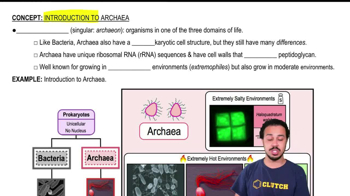Genetic variation in bacterial populations cannot result from a. transduction. b. conjugation. c. mutation. d. meiosis.
Ch. 27 - Bacteria and Archaea
Chapter 27, Problem 3
Which of the following statements is true? (A)Archaea and bacteria have identical membrane lipids. (B)The cell walls of archaea lack peptidoglycan. (C)Prokaryotes have low levels of genetic diversity. (D)No archaea are capable of using CO2 to oxidize H2, releasing methane.

Verified Solution
Video duration:
2mWas this helpful?
Key Concepts
Here are the essential concepts you must grasp in order to answer the question correctly.
Differences between Archaea and Bacteria
Archaea and bacteria are both prokaryotic organisms, but they differ significantly in their membrane lipids and cell wall composition. Archaea have unique ether-linked lipids, while bacteria typically have ester-linked lipids. Additionally, the cell walls of archaea do not contain peptidoglycan, which is a characteristic feature of bacterial cell walls.
Recommended video:
Guided course

Introduction to Archaea
Prokaryotic Genetic Diversity
Prokaryotes, which include both bacteria and archaea, exhibit high levels of genetic diversity due to mechanisms such as horizontal gene transfer, mutation, and rapid reproduction. This diversity allows them to adapt quickly to changing environments, contradicting the notion that they have low genetic diversity.
Recommended video:
Guided course

Prokaryote Lineages 1
Methanogenesis in Archaea
Methanogenesis is a metabolic process carried out by certain archaea, where they use carbon dioxide (CO2) to oxidize hydrogen (H2), producing methane (CH4) as a byproduct. This process is crucial in various ecosystems, particularly in anaerobic environments, and highlights the unique metabolic capabilities of archaea compared to other organisms.
Recommended video:
Guided course

Introduction to Archaea
Related Practice
Textbook Question
999
views
Textbook Question
Photoautotrophs use a. light as an energy source and CO2 as a carbon source. b. light as an energy source and methane as a carbon source. c. N2 as an energy source and CO2 as a carbon source. d. CO2 as both an energy source and a carbon source.
1234
views
Textbook Question
Which of the following statements is true?
a. Archaea and bacteria have identical membrane lipids.
b. The cell walls of archaea lack peptidoglycan.
c. Prokaryotes have low levels of genetic diversity.
d. No archaea are capable of using CO2 to oxidize H2, releasing methane.
20
views
Textbook Question
Which of the following involves metabolic cooperation among prokaryotic cells? a. binary fission b. endospore formation c. biofilms d. photoautotrophy
630
views
Textbook Question
Which of the following describes a bacterium that lives in the human intestine and causes disease?
(A)commensalist
(B)decomposer
(C)gut mutualist
(D)symbiotic pathogen
834
views
